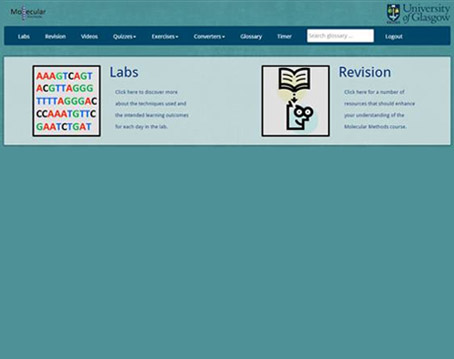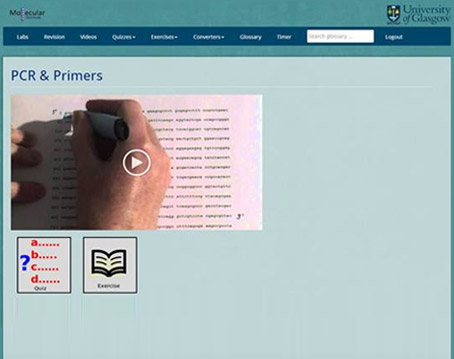Case studies
A showcase of E-learning being carried out in the College of Medical, Veterinary and Life Sciences.
Cancer in the 21st century – the genomic revolution
Cancer in the 21st century – the genomic revolution is a free 6-week MOOC (massive open online course) delivered by the School of Medicine, Dentistry & Nursing and the School of Cancer Sciences.
The course reveals how genetics has revolutionised the detection and treatment of cancer, and how these may develop in the future, and gives insight into patient experiences as well as talks on key issues with specialists and guest lecturers.
The MOOC will run again August 17th 2015 for 6 weeks.
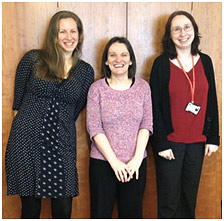 One of the creators of the "Cancer in the 21st century – the genomic revolution" MOOC, Dr Leah Marks, describes her experiences developing the MOOC:
One of the creators of the "Cancer in the 21st century – the genomic revolution" MOOC, Dr Leah Marks, describes her experiences developing the MOOC:
Why did you decide to put forward a proposal for a MOOC for this subject?
My particular area of interest with regards to teaching is in Medical Genetics so originally this was something I thought about choosing as the topic. However, while looking around the various other MOOC platforms there seemed to be an abundance of genetics courses, probably due to this area being quite topical. However what really stood out for me was the dearth of courses on the subject of cancer, an area so huge that at first I was hesitant of tackling it. But with the abundance of first class research as well as a wealth of teaching expertise in this area in Glasgow University I thought it would be an excellent subject to deal with, as well as being of widespread interest.
What challenges or surprises did you face during the project?
The amount of work involved! Co-ordinating a large team of people from many different parts of the university was something of a new experience for me and although hugely challenging was very enjoyable. I also learned a lot about the work involved in producing high quality video and will be forever indebted to the staff at media services!
Have your experiences with developing this MOOC impacted your approaches to teaching?
I think the approach of ‘chunking’ material into bite size pieces is one which has remained with me. All the videos on the MOOC were less than 10 minutes long and it really made me think about the key messages that I was trying to get across. When you’ve got such a short space of time there’s no room left for waffle and it’s definitely made me look more closely at how I communicate with students on a day to day basis.
What takeaway do you have for colleagues interested in exploring online learning concepts?
Have a go and see how you get on – don’t be afraid of trying! But be prepared to work very hard on it, it’s not a case of just taking your offline material and putting it on a website. You really have to think carefully about what you’re doing and why you are doing it. And don’t be afraid to ask colleagues for help, you’ll probably find that there are others with a huge range of expertise very willing to get involved, but you’ll need to let them know why it’s a good idea first.
Professor Anna Dominiczak, Regius Chair of Medicine, Vice Principal and Head of College said, ‘Cancer medicine has been benefiting greatly from the modern genetics and genomics with the next generation sequencing bringing personalised or stratified medicine to the clinic. This new course will help you to understand this genomic revolution.’
Cancer in the 21st century – the genomic revolution is run in partnership with FutureLearn.
The course also offers opportunity to purchase a 'Statement of Participation'.
|

The Flipped Classroom
Flipped classroom"Flipped classroom is a form of blended learning in which students learn content online by watching video lectures, usually at home, and homework is done in class with teachers and students discussing and solving questions." Flipped classroom - Wikipedia |
The Dental Clinical Skills Unit recently developed a flipped classroom model for teaching operative techniques, placing the majority of their didactic teaching and demonstrations online.
Dental students access videos, presentations, lesson plans, and other educational resources (via Moodle) prior to attending classes - while classes provide the opportunity for practical work and reflection and critical appraisal of the students' own work.
This active learner centred approach has resulted in enhanced student feedback with additional opportunity for teachers to model technical procedures and skills on an individual basis; and as practical skills time is maximised, students are identifying their own learning needs while proceeding with course material at a more personal pace.
Further reading: "Enhancing the learning experience in dental clinical skills: development of a flipped classroom model" [pdf] by
Dr Andrew Crothers, Flipped Classroom Developer
Dr Andrew Crothers is Clinical Senior University Teacher in the Dental School, with research interests in the field of Dental Education and in the use of technology to assist teaching, learning and assessment. Here Dr Crothers describes his experience developing the flipped classroom model:
"I first thought about flipping my clinical skills teaching whilst preparing material for delivery on Moodle – traditionally the first hour or so of a practical class consisted of a live demonstration of a technique which the students viewed on their own desktop monitors in the lab. It seemed like a good idea to record these for revision purposes at first, but it became clearly evident there was little point students watching this is the lab with their patient simulator sat idle in front of them. They might as well do this in their own time and at their own pace. I’d become aware of the flipped model from attending a JISC conference, it seemed a good model to take on board. A quick search indicated that the model had not been tried out for this type of practical class, so I put together a programme of study for my year 2 students.
The decision to do this was obvious –students would have more time with hands on work, and staff would be able to guide and model techniques one to one. Students also had more autonomy in their studies, as the use of their own mobile devices in the classroom helped them progress through the material at a more individual pace.
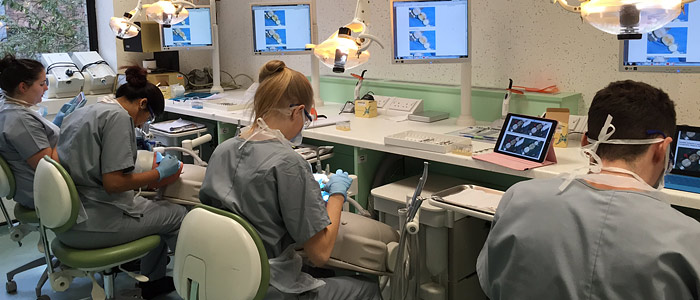
The students took to it immediately. My initial worry was that students would not access the material prior to the class, but it became evident that any individual who did not engage online quickly realised the benefits of online preparation once the practical work started. The staff members were also supportive, and appreciated the extra time they could devote to individual students learning needs.
The course component has now finished. The feedback to date strongly supports this learning strategy and students are now requesting other practical components to be delivered in this way, which is now being planned.
On a personal level, replacing live demonstrations with recorded multimedia material initially gave me pause for thought. However, the time released gives a much greater opportunity to tailor guidance on a more individual basis. Preparing the material is time consuming, but allows optimal use of a resource intense teaching environment."
Further reading: "Enhancing the learning experience in dental clinical skills: development of a flipped classroom model" [pdf]

Digital SlideBox Pathology Case Studies
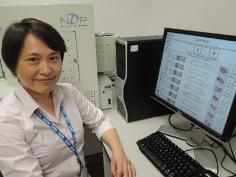 Dr Tomoko Iwata is a Senior Lecturer in the Undergraduate Medical School and an associate Academic in the Institute of Cancer Sciences.
Dr Tomoko Iwata is a Senior Lecturer in the Undergraduate Medical School and an associate Academic in the Institute of Cancer Sciences.
Dr Iwata developed Pathology Case Studies using Digital SlideBox for UG and MSc courses, the first running in the BScMedSci Mechanisms of Disease in 2012-13 sessions, then in MSc TMS Molecular pathology in the following year.
We asked Dr Iwata to talk about her Pathology Case Studies project.
Can you explain to us the background to this project?
"When our Academic Unit of Medical Genetics and Pathology moved to the University’s Southern General Hospital campus in 2013, my plan was to develop and coordinate mainly two courses based in this facility: an undergraduate intercalated year medicine specialist course - BScMedSci Clinical Medicine “Mechanisms of Disease” (Pathology) - and research methodology in Molecular Pathology course - MSc Translational Medical Sciences.
Taking advantage of the unique environment being inside the NHS GG&C Department of Pathology and next the NHS GG&C Biorepository, I wanted to build in a course component that offers good integration of clinical environment and university's academic research atmosphere.
Digital SlideBox is a web-based teaching software for the existing “SlidePath” Digital Image Hub (Leica Biosystems). SlidePath enables users to not only view images of scanned microscopic slides with tissue sections at high resolution just like using the microscope, but also allows users to annotate, capture images, programme various algorithms to count cells and measure areas of interest.
Currently 6 cases are featured in the Digital SlideBox Pathology Case Studies (started off with 4 cases initially). Each case is designed for 1.5 hour session in a computer cluster with a facilitator. Manoeuvring the site online is very easy and sometimes students are even better at this than the staff. "
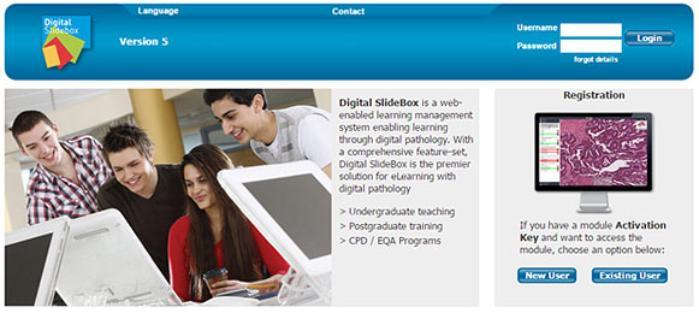
Opening page of Digital SlideBox
How has the case studies project been received? What have you learned?
"Digital SlideBox Pathology Case Studies have been received very well by the students of both BScMedSci and MSc TMS Molecular pathology so far. The students are engaged deeply with the materials in a way different from lectures, tutorials, or even literature reviews.
In case of medical students, they appear to use the case studies as a confirmation of knowledge with actual cases, rather than striding into new sets of knowledge or skills in recognizing morphological features. In contrast, master level students appear to appreciate the fact that the cases are real, and use these materials as a starting point to learn disease mechanism.
Students tend to like the simple cases (shorter case history and fewer slides to view) rather than those that have a complex story behind or a systematic review of a disease. This could be because the information that tissue morphology contains can be huge and it requires time and persistent attention for students to go through them. Indeed, simpler cases could be more effective in terms of delivering the key messages and could also allow students to spend time in exploring more of what morphology may convey.
I also felt that our Digital SlideBox Pathology Case Studies may be a good way to make pathology and clinical topics less intimidating to students with non-medical background, such as life science or biotechnology. Simplified versions of the cases were used in School of Medicine Summer School: An Introduction to Medical Sciences – lifecycle, development and disease in 2014 and the students appeared to have enjoyed them."
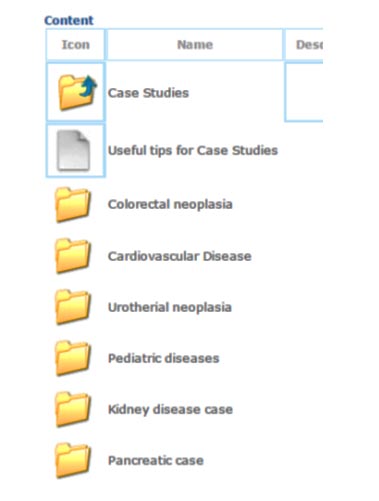
Current 6 pathology cases
What were the challenges you faced?
Our Digital SlideBox Pathology Case Studies are by no means completed, and they require more trials and revising. The software is new and contains several glitches. Some aspects are not very user friendly. Specifically to our courses, it is difficult to set effective questions or generate tasks to make students to obtain skills in recognizing certain morphological characteristics. Use of this software in formative and summative assessments is possible, but requires more explorations.
Students have raised that recognition of certain morphological features are challenging and real-time affirmation by the lecturers would help. Currently our Digital SlideBox Pathology Case Studies are held in the “tutorial” style in a class room with a facilitator, who assists or confirms students’ observations, answers, ad to discuss matters as they arise. This format is suitable for a small number of students, however alternative approach needs to be developed in future for bigger number of students expected for the master level courses."
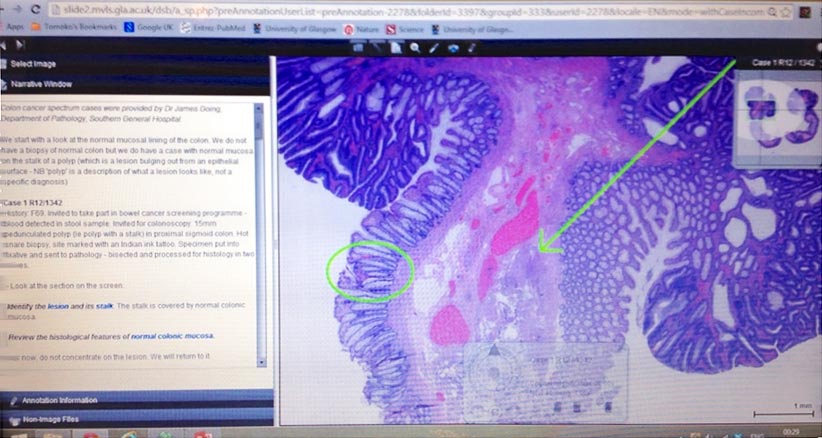
Example case: case history on the left plan and the scanned slide on the right which you can annotate in any way you can
What future development of online pathology case studies are you planning?
"Overall our experiences so far show that Digital SlideBox is suitable for generation of pathology case studies and for delivering web-based course materials in the class room. It is relatively easy to work out how to use and it certainly offers nearly unlimited possibilities in the way the pathology cases are delivered to the students.
The web-based nature of Digital SlideBox Pathology Case Studies offers flexibility in the way students and staff can access the courses materials. In principle, as this is web-based, students can access it from any computer with internet connection. The main challenge remains to be on how to provide facilitation, either in person, or fully web-based.
Our unit of Medical Genetics and Pathology is ready for e-Learning environment. Our pathology seminar room is equipped with the Eco360 recording system. Last year, Eduroam was introduced to allow students to use their own computers or iPads. Finally, in order to facilitate interaction of students to pathologists and clinical lab scientists, a “write-up” room was arranged to become a small computer cluster (“iCluster”) and the Digital SlideBox-based teaching are now delivered on site within our unit.
Being embedded in the NHS Department of Pathology, our unit is an ideal base to obtain cases for teaching and training purposes. All we need from the busy pathologists is a small number of pathology slides and a brief case history on one page of A4. In future, my intention is to generate the cases that cover the most active research areas in Glasgow, including cancer, immune and infectious diseases, and cardiovascular diseases. Furthermore, I wish to explore the potential of our Digital SlideBox Pathology Case Studies to be structured into a full online-teaching resource that can be made available nationally and internationally. This will be an excellent model for Molecular Pathology teaching and training for learners with both clinical or science background. "
Dr Tomoko Iwata is based in the Medical Genetics and Pathology unit of the University’s Southern General Hospital campus.

Interactive online resources for dental education
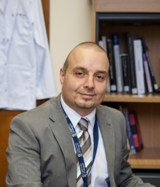
Dr Ziad Al-Ani of the Dental School describes his experiences developing and delivering interactive online resources for dental education.
"The resources we produce in the Scottish Dental Education Online (SDEO) are quality-assured by leading experts in dentistry and education, developed to agreed standards and specifications to meet technical/ethical/legal requirements.
Two types of resource are available:
• Stand alone learning packages that learners can use independently
• Learning objects that lecturers can incorporate into the material they produce for students
The interactive packages include:
- Oral cancer interactive package is included in Oral Surgery and Oral Medicine category and it deals with knowledge of the clinical presentation, diagnosis and pathology of oral cancer and referral process
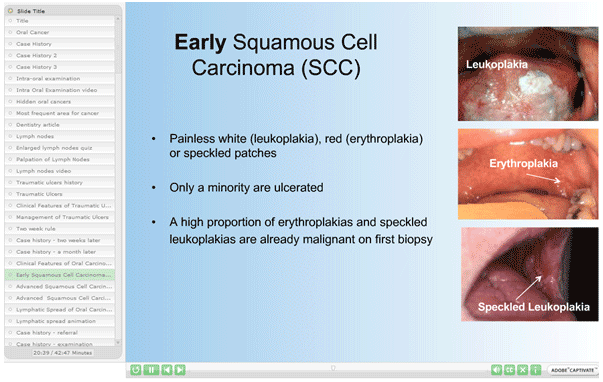
- Common Odntogenic Cysts interactive package discusses the principles of pathology and clinical presentations of common cysts as well as the common radiological investigation technique requires to confirm the diagnosis
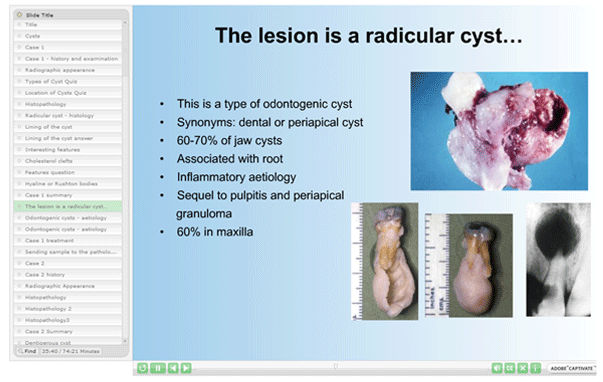
- Swallowing package is included in Anatomy and Physiology category. This package explains the feeding sequence including the different phases of swallowing and describes the difference between liquid and solid food swallowing
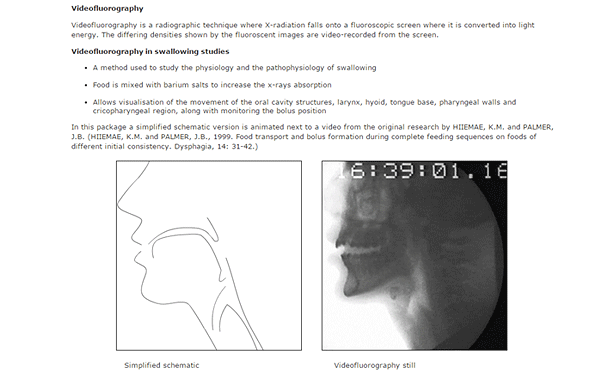
I use these learning resources in my teaching and I found it very enjoyable as they make lectures and tutorials more interactive and engaging. The initial feedback by students is very encouraging."

From Microscope to Movies: 3D animations for teaching physiology
 Dr. Craig Daly, School of Life Sciences, recognising the effectiveness of medical animations for teaching and learning, developed a series of physiology 3D animations with funding by a Teaching Award from the Physiological Society. He explains:
Dr. Craig Daly, School of Life Sciences, recognising the effectiveness of medical animations for teaching and learning, developed a series of physiology 3D animations with funding by a Teaching Award from the Physiological Society. He explains:
"My novel approach is to combine 3D microscopy with Pixar-style animation software. The resulting animations are anatomically correct to within 0.1mm and are therefore not ‘artists impressions’ (unlike most physiology-based animations you will find on You-Tube)."
Dr Daly is currently working with Paul McLeod (animator & 3D Artist within MVLS) to develop a series of educational animations for himself and colleagues. These include:
- Peri-vascular fat (Daly)
- Fly Gut Physiology (Dornan)
- Meningeal Structure (Coles)
- Early Stage Embryology (Welsh)
- Ichthyosaurus (Clark - Hunterian Museum)
- Drug-Receptor Interaction (Aidulis)
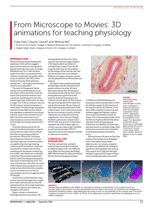
From Microscope to Movies: 3D animations for teaching physiology
pdf of article published in Microscopy & Analysis.

Molecular Methods project
Dr Pamela Scott, Dr Nicola Veitch, Dr Helen Gadegaard and Dr Michelle Welsh were behind the design of "Molecular Methods", an app to compliment a series of webinars produced for their Molecular methods course. Here the doctors describe their experience of digital technology and e-learning.
Our App project
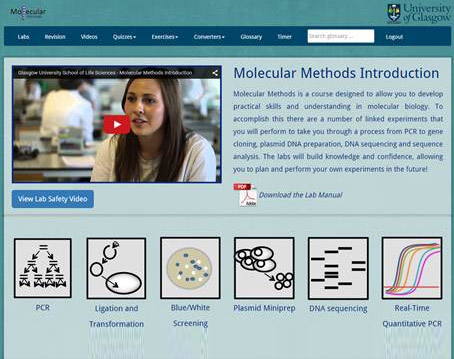
Digital media technology has been used to develop laboratory support resources for our undergraduate School of Life Science students at the University of Glasgow undertaking a Molecular Methods course. This taught and practical unit is given to all Level 3 undergraduate students undertaking degrees in every biological discipline. Molecular Biology is a conceptually difficult subject area and students outwith the Biomolecular Science degree often struggle to engage with molecular material.
Our aim was to develop a novel approach to aid student understanding of particular challenging aspects of the course. Using multimedia tools, bespoke resources have been developed, including help webinars, linked quizzes and a web app, in order to enhance understanding of practical sessions, thus enabling our students to take responsibility for and direct their own learning and encourage inquiry-based learning skills. These resources were created in collaboration with graduate teaching assistants (GTAs) and undergraduate students (Life and Computing Science students) and was supported by a grant from LTDF. This has provided us with an opportunity of collaborating with staff within other Schools, allowed us to learn more about the impact that digital technology has on student learning and this has led to presentation of our work at conferences, resulting in an award at the HEA 2014 Annual Teaching and Learning Conference.
Our Webinar series
Molecular biology is a conceptually difficult topic. It’s ubiquity in public and scientific press means that students outwith Biomolecular Science degrees have a requirement to understand these technologies too, and as a mandatory part of their taught courses, often struggle with it. However, it is important that all Life Sciences students comprehend the central concepts as these techniques are used across biology and are applied in many areas including hospital diagnosis, forensic science and pharmaceuticals.
The purpose of the webinars was to enhance student comprehension of key elements of the course that they had previously reported to us as difficult to understand. These resources would enable our students to take responsibility for and direct their own learning and encourage inquiry-based learning skills: key UoG graduate attributes to generate investigative responsible learners. Since creation of the YouTube channel ‘Molecular Biology Explained’, we have come to recognise the need for clear explanation of these concepts which has been recognised from the thousands of hits our videos have received worldwide and the many supporting comments, for example, ‘Thank you, you explain so well! I didn't understand half of this in class!’.
Feedback so far
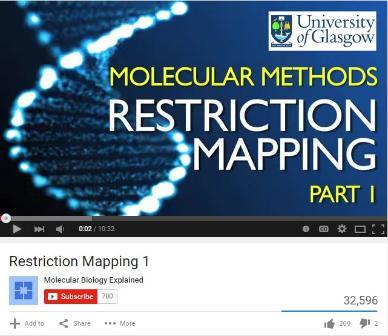 In a questionnaire and focus group following completion of Molecular Methods, we asked for feedback with regards how useful the resources were to help their understanding of various aspects of the course. A resounding 96% of students found the new digital resources useful for their learning. Students comments included ‘clear and easy to use. Different learning style, more interactive’, ‘the app content was well integrated with the course’ and ‘more like this please! Very helpful’, ‘very helpful. There is no excuse in this course for not understanding its concepts as there is an abundance of resources’.
In a questionnaire and focus group following completion of Molecular Methods, we asked for feedback with regards how useful the resources were to help their understanding of various aspects of the course. A resounding 96% of students found the new digital resources useful for their learning. Students comments included ‘clear and easy to use. Different learning style, more interactive’, ‘the app content was well integrated with the course’ and ‘more like this please! Very helpful’, ‘very helpful. There is no excuse in this course for not understanding its concepts as there is an abundance of resources’.
82% of students found the webinars useful for their learning. 74% of students found the app easy to use and 61% believed it enhanced their learning.
Future developments
The App and digital resources will continue to be maintain and diversify. Ultimately, we would like to develop, implement and evaluate laboratory based virtual lab learning environments and animations for identified groups of undergraduate (UGT) and postgraduate (PGT) School of Life Science (SoLS) students to encourage enhanced student engagement via blended learning and thus promote student-centred and independent learning during class. The idea is not to replace the real-life laboratory based practicals but complement them, thereby improve student learning experience. Funding is being sought to do this.



